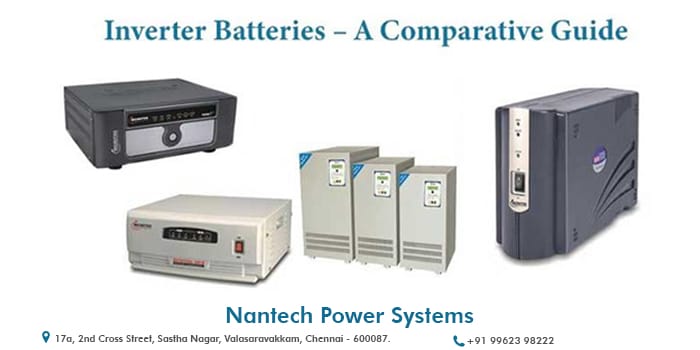- Home
- About us
- Products
- Dealer Enquiry
- Blog
- Contact Us
- Home
- About us
- Products
- Dealer Enquiry
- Contact Us
- 044 -2486 1994
- +91 99623 98222
- sales@nantech.in
- REQUEST A QUOTE

Inverters have become commonplace in homes and commercial establishments in India. In fact, as power cuts became a routine in Chennai, people have started to rely on inverters for continuous power supply to operate household appliances and commercial equipment. Inverters generate power from batteries. Let us learn more about inverter batteries, their types and their characteristics.
Batteries are storage devices capable of storing power. Inverters draw out the stored energy during power cuts. Inverters use batteries that are chargeable to generate electricity. They convert AC into DC which can power consumer appliances. They charge the batteries when the power supply is available.
There are different types of batteries in the market. Many consumers are often unaware of these types and are left wondering about which one to choose. When in doubt, it is best to get the opinion from experts. Nantech is a leading inverter tubular battery dealer in Chennai, with several years of experience in the field, and can guide you with the right choice.
Rechargeable batteries contain two electrodes dipped in an electrolyte solution. The electrodes are essentially two solid plates and the electrolyte is a liquid or a gel. The chemical reaction between the electrodes and electrolytes causes the formation of DC current. These chemical reactions are reversible, making the battery rechargeable. How interesting is that!
In a Lead Acid Battery, lead and lead dioxide are the electrodes, and sulphuric acid acts as the electrolyte solution. Electrodes dipped in sulphuric acid result in a chemical reaction that generates the DC current.
Often, people are misled by various terms used for inverter batteries. You may have heard about lead acid batteries, tubular batteries, flat plate batteries, etc. The commonly known batteries are the lead acid batteries. Let us now break a common misconception. Tubular batteries and flat plate batteries are two types of lead-acid batteries. Yes! People use lead acid batteries and flat plate batteries interchangeably, but in reality, tubular batteries are also lead acid batteries.
Thus, Lead-acid batteries are of two types– Flat plate batteries and Tubular Batteries.
Also Read: Why Is An Inverter Supplier In Chennai Important For Smart Homes?

Tubular batteries and flat plate batteries work on the same principle. However, there are some minor technical differences between the two.
The foremost difference is the positive plate. The positive plate is the critical component of the battery. The life of the battery depends on the structure of the plate. It is also a weaker plate and can wear out in the long run on repeated charging and recharging.
The structure of the positive plate is the primary distinguishing feature between the two types of batteries.
In a flat-plate battery, the positive plate is a grid-like structure, and due to the larger surface area, they are prone to corrosion. On the other hand, in the tubular battery, the active material is concealed inside tubes made of fabric replacing the positive plate. This tube ensures lesser corrosion and provides an increased life span to the battery.
Let us now have a comparative study of the two types of batteries. This will enable you to decide the one that fits your needs.
| Feature | Tubular Batteries | Flat Plate Batteries |
|---|---|---|
| Electrodes | Positive tube, Negative plate | Positive, Negative Plates |
| Battery Life | High (lasts up to 5 years) | Low (maximum of 3 years) |
| Efficiency | Lesser wastage of power | More wastage of power |
| Cyclic time | High | Low |
| Maintenance | Low | High |
| Charging time | Charges fast | Charges slower than tubular |
| Water Loss | Low water loss | Need periodic water toppings |
| Weight | Heavy | Light |
| Application | Suitable for high-end applications as well as homes | Suitable for small homes |
| Temperature | Can operate hassle-free in high temperature | Used at recommended temperature conditions |
| Price | Priced higher than Flat plate | Economical |
| Design | Complex | Simple |
In general, tubular batteries have at least 20% more electrical capacity than their flat plate counterparts. They are often called the deep cycle batteries due to their much greater run times.
We have listed the critical differences between the two types of batteries. When trying to buy a battery for residential or commercial use in Chennai, please keep these differences in mind and choose the right one that fits your power consumption needs.
Aspects To Consider While Purchasing A Solar Inverter
Emerson UPS Preventive Maintenance Checklist – Get To It!
Understanding The UPS( Uninterruptible Power Supply)
Evolution In EV Charging Infrastructure
Why Is It A Must To Invest In UPS or Inverter in Chennai?
Modular UPS Versus Conventional UPS: Differences Decoded
Uncovering the Game-Changing Benefits of Modular UPS Systems
Maximising Inverter Battery Performance: Key Factors to Consider